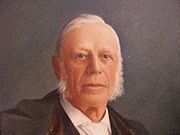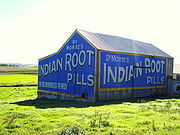
Dr. Morse's Indian Root Pills
Encyclopedia

North America
North America is a continent wholly within the Northern Hemisphere and almost wholly within the Western Hemisphere. It is also considered a northern subcontinent of the Americas...
as part of the lucrative patent medicine
Patent medicine
Patent medicine refers to medical compounds of questionable effectiveness sold under a variety of names and labels. The term "patent medicine" is somewhat of a misnomer because, in most cases, although many of the products were trademarked, they were never patented...
industry, which thrived during most of the 19th and 20th centuries. Its manufacturer claimed the pills contained herbal ingredients that would help "cleanse the blood," as "impurity of the blood" was believed to be the cause of all disease.
History

The Indian Root Pills were first formulated and manufactured in 1854 by Andrew B. Moore
Andrew B. Moore
Andrew Barry Moore was the 16th Governor of the U.S. state of Alabama from 1857 to 1861, and served as Governor at the outbreak of the American Civil War....
, who was then operating under the name A.B. Moore in Buffalo, New York
Buffalo, New York
Buffalo is the second most populous city in the state of New York, after New York City. Located in Western New York on the eastern shores of Lake Erie and at the head of the Niagara River across from Fort Erie, Ontario, Buffalo is the seat of Erie County and the principal city of the...
. Rights to the pills were then transferred through a number of different business partnerships under the control of Moore, Andrew J. White, Baldwin L. Judson, George Wells Comstock and his nephew, William Henry Comstock
William Henry Comstock
William Henry Comstock was an American/Canadian businessman and politician.Born in Batavia, New York, Comstock was educated in Flushing, New York, and on leaving school started work as a clerk. He started his business in 1854, William H. Comstock Company, Ltd., which sold patent medicine including...
. These reorganizations all occurred amid numerous disputes and lawsuits. During that long period of instability, the manufacturing operations moved from Buffalo
Buffalo, New York
Buffalo is the second most populous city in the state of New York, after New York City. Located in Western New York on the eastern shores of Lake Erie and at the head of the Niagara River across from Fort Erie, Ontario, Buffalo is the seat of Erie County and the principal city of the...
to New York City
New York City
New York is the most populous city in the United States and the center of the New York Metropolitan Area, one of the most populous metropolitan areas in the world. New York exerts a significant impact upon global commerce, finance, media, art, fashion, research, technology, education, and...
and then to dual sites on opposite sides of the St. Lawrence River, one at Brockville, Ontario and the other at Morristown, New York. Ownership of Dr. Morse's Indian Root Pills finally stabilized in 1867 when it settled solely in the hands of William Henry Comstock, and thereafter business was carried out under the name W.H. Comstock Co. Ltd.
When William Henry Comstock died in 1919, control of the company passed to his son, William Henry Comstock II, known as "Young Bill." William Henry Comstock II died in 1960, and W.H. Comstock Co. Ltd. ceased operations a year later, patent medicines having already been in decline.
External links
- Project Gutenberg: History of the Comstock Patent Medicine Business and Dr. Morse's Indian Root Pills by Robert B. Shaw
- 'Restored in 2000 by Letterheads' Advertisement for Dr Morse's Indian Root Pills on an old shed outside Morpeth, NSW, Australia. Research and Restoration Project Team Leaders... David Beattie, Gail Beattie, Michael George.

